In 1980 the Ritmo diesel was introduced
with the 1714cc engine (55bhp) from the 132. Numerous
small changes accompanied this, such as modeified suspension to cope with
the extra weight. In the following year the 'Ritmo Super' was introduced
with a variety of small changes and, most significantly, revised engines
with 75bhp (1300) and 85bhp (1500). Also in 1981 was born the first sporting
Ritmo, the 105TC. This used a 1585cc dohc engine derived from that in the 131
producing 105bhp (increased compression ratio, modified ports, valves and
exhaust). The brakes, suspension, wheels, tyres, gearbox, clutch and external
trim were also modified. In 1982 the second series 'New Ritmo' was
introduced. This had a new front end, with four round headlights and a
new grille incorporating the new FIAT badge. Numerous small changes were
made, and all the engines were developed in order to reduce the fuel consumption.
This was also helped by an improvement in drag coefficient to 0.40. These
changes were carried across to both the three and five door cars, the cabriolet,
the diesel and to the sporting models.
Launched in June 1983, the Abarth 130TC,
which replaced the 125TC, was the ultimate sporting Ritmo, having a 1995cc
dohc engine, twin 40 DCOE carurettors, improved brakes, a close ratio ZF
gearbox and numerous other detail modifications.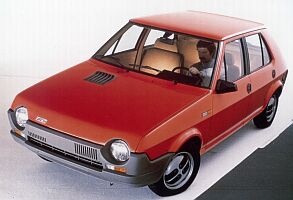 The
Ritmo was first released at the Turin Motorshow in 1978. Designed by Bertone,
it was available with three or five doors, with a drag coefficient of 0.44,
and three petrol engines sized 1116cc (60bhp), 1301cc (65bhp) and 1498cc
(75bhp) Four and five speed (standard in 75, optional in the others) gearboxes
were complemented by a 3 speed automatic VW unit. Two trim levels were
available 'L' and 'CL'. In English speaking countries the Ritmo was called
'Strada', and when it first went to the US in 1979 it had numerous modifications,
including a new grille and bumpers and the 1500 engine modified to meet
US emissions laws (resulting in a loss of power to 65bhp). From early 1979 the Ritmo 60 used the Brazilian made 1050cc engine.
The
Ritmo was first released at the Turin Motorshow in 1978. Designed by Bertone,
it was available with three or five doors, with a drag coefficient of 0.44,
and three petrol engines sized 1116cc (60bhp), 1301cc (65bhp) and 1498cc
(75bhp) Four and five speed (standard in 75, optional in the others) gearboxes
were complemented by a 3 speed automatic VW unit. Two trim levels were
available 'L' and 'CL'. In English speaking countries the Ritmo was called
'Strada', and when it first went to the US in 1979 it had numerous modifications,
including a new grille and bumpers and the 1500 engine modified to meet
US emissions laws (resulting in a loss of power to 65bhp). From early 1979 the Ritmo 60 used the Brazilian made 1050cc engine.
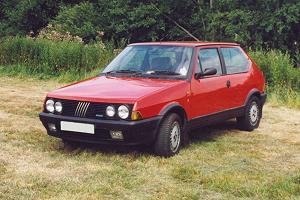 And
at the Frankfurt Motorshow a few months later (but still in 1981) the Ritmo
Abarth 125TC was shown. This was a heavily modified 105TC with a 1995cc
dohc with 125bhp, ventilated front discs, a new ZF gearbox, revised suspension
settings and strengthened components. At the same show Bertone showed a
prototype Ritmo cabriolet. This entered low volume production early the following year.
And
at the Frankfurt Motorshow a few months later (but still in 1981) the Ritmo
Abarth 125TC was shown. This was a heavily modified 105TC with a 1995cc
dohc with 125bhp, ventilated front discs, a new ZF gearbox, revised suspension
settings and strengthened components. At the same show Bertone showed a
prototype Ritmo cabriolet. This entered low volume production early the following year.
February 1986 saw the Ritmo fitted with
a 1929cc turbocharged and intercooled diesel engine with 80bhp. Only available
with a five-door body it got a new front bumper as well as a revised interior
and featured power-steering, central locking, electric windows, rear wiper
and tinted glass as standard.
Before production stopped in 1988, catalysed
versions of the 1498cc and 1585cc engines were produced for some markets,
becoming the 75ie and 90ie due to the slight drops in power.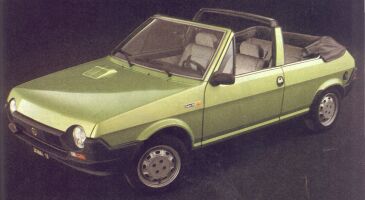 1985
saw the third series released. Numerous small design changes were made,
both internally and externally (easily recogniseable by the square, rather
than round, door handles). The 1714cc diesel engine was replaced by a 1697cc
unit with 60bhp. The 'Supercabrio' was also released, using the 105bhp
1598cc engine. The 'Cabrio' continued in production, adopting the 1301cc (65bhp) engine.
1985
saw the third series released. Numerous small design changes were made,
both internally and externally (easily recogniseable by the square, rather
than round, door handles). The 1714cc diesel engine was replaced by a 1697cc
unit with 60bhp. The 'Supercabrio' was also released, using the 105bhp
1598cc engine. The 'Cabrio' continued in production, adopting the 1301cc (65bhp) engine.
Technical Details
| Driveline | transverse engine at front front wheel drive |
| Engines |
1116cc (80x55.5mm) sohc four cylinder with 60bhp @ 5,800rpm (later 55bhp @ 5,600rpm, later still 58bhp)
1301cc (86.4x55.5mm) sohc four cylinder with 65bhp @ 5,800rpm (later 68bhp @5,700rpm) 1498cc (86.4x63.9mm) sohc four cylinder with 75bhp @ 5,800rpm 1049cc (76x57.8mm) sohc four cylinder 1290cc (86x55.5mm) sohc four cylinder with 75bhp @ 6,000rpm 1498cc (86.4x63.9mm) sohc four cylinder with 85bhp @ 6,000rpm (later 82bhp @ 5,800rpm) 1585cc (84x71.5mm) dohc four cylinder with 105bhp @ 6,100rpm 1995cc (84x90mm) dohc four cylinder with 125bhp @ 5,800rpm (later 130bhp @ 5,900rpm) 1714cc (83x79.2mm) sohc four cylinder diesel with 55bhp @ 4,500rpm (later 58bhp) 1697cc (82.6x79.2mm) sohc four cylinder diesel with 60bhp @ 4,500rpm 1929cc (82.6x90mm) sohc four cylinder turbo diesel with 80bhp @ 4,200rpm |
| Suspension | front : MacPherson strut with telescopic dampers and coil springs (automatic trans plus anti-roll bar)
rear : Lower wishbone with telescopic damper and transverse leaf spring wheelbase (MkI) : 2448mm; (MkII) : 2444mm; (125 & 130TC) : 2432mm front track : 1400mm (MkI); 1409mm (MkII), 1455mm (105/125/130TC) rear track : 1410mm (MkI); 1414mm (MkII), 1420mm (105/125/130TC) |
| Brakes | front : discs, diameter 227mm
(except early 105TC : 251mm, late 105TC 257mm, 125TC & 130TC 243mm vented) rear : drums, diameter 185.5mm dual circuit with servo assistance handbrake operating on the rear by cable |
| Gearbox | 4 and 5 speed manual
3 speed automatic cable operated clutch, disc diameter 181.5mm (1100 & 1300), 190mm (1500), 200mm (TC) |
| Steering | Rack and pinion
3.5 turns lock to lock |
| Kerb weight | series I : 3 door : 895kg, five door : 911kg (US models 919kg and 935kg respectively)
series II : 3-door : 815kg, 5-door : 880kg 125TC : 980kg Cabrio : 930kg 130TC : 950kg |
| Dimensions | click here. |
click here for a cutaway view of a Ritmo/Strada
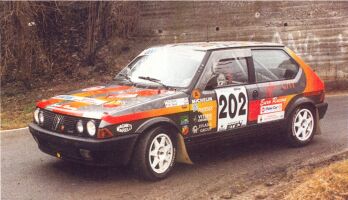 Performance
Performance
| model | max speed | 0-100kph/0-60mph | standing km |
| 60L (1979) | 142 km/h | 16 sec | 37.13 sec |
| 75CL Automatic (1979) | 153 km/h | 14 sec | 35.6 sec |
| 105TC (series I) | 109 mph | 9.7 sec | |
| 125TC (series I) | 118 mph | 8.4 sec | |
| 130TC | 122 mph | 7.7 sec |
Tuning
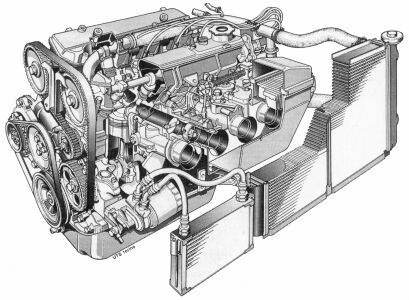 There are three main areas to concentrate
on, the engine (and transmission), the brakes and the suspension and then
various other details. These three should be done together since they complement
each other, not all of one and none of another !
There are three main areas to concentrate
on, the engine (and transmission), the brakes and the suspension and then
various other details. These three should be done together since they complement
each other, not all of one and none of another !
1. The engine.
Before modifying the engine it is worthwhile
filling it with a good quality synthetic oil and fitting new spark plugs.
An engine oil additive may also be used.
The first improvements are relatively simple.
The air filter can be replaced for an aftermarket item which will help
the engine breathe more
freely, the type which completely replace the original airbox are best,
and the exhaust can be replaced for one which will restrict the exit of the gases less.
The main modification (outside of taking
the engine apart) is to fit a better carburettor. For the sohc versions,
twin downdraught DCNFs are possible, whilst for the twin cams upgrading
to 45 DCOE's will provide gains. A camshaft will also provide a noticeable
gain, especially if fitted in conjuction with the carburettor.
Other things to do should include fitting
a cold air intake, a large diameter pipe (minimum 5cm) to provide air from
outside the engine bay to the air filter. The exhaust manifold can also
be lagged with thermal cloth or tape to keep the exhaust gases hotter (and
thus reduce back pressure) and also to keep the underbonnet (and hence
intake and fuel) temperatures lower.
Regarding the transmission the main requirement
is to uprate the clutch to handle the increase in power and torque achieved
though the engine modifications. Friction plates can be purchased with
improved materials and heavier duty pressure plates are also available.
Whilst doing this it is worthwhile lightening the flywheel.
The high tension leads can also be replaced with performance ones.
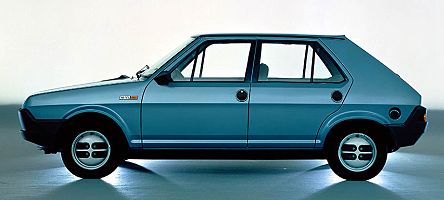 Further modifications require the machining
of the cylinder headand/or cylinder block (which will not be dealt with
here since it is not normally a DIY job) after which it may be worth fitting
an oil cooler. If overheating is a problem due to the increased power output
then a small hole can also be drilled through the plate in the thermostat.
There are a multitude of company's with experience of internal cylinder
head modifications for the FIAT twin cam engine, and a 1995cc engine with
45 DCOE's and a gasflowed head should produce over 150bhp. The single cam
engine is also well catered for.
Further modifications require the machining
of the cylinder headand/or cylinder block (which will not be dealt with
here since it is not normally a DIY job) after which it may be worth fitting
an oil cooler. If overheating is a problem due to the increased power output
then a small hole can also be drilled through the plate in the thermostat.
There are a multitude of company's with experience of internal cylinder
head modifications for the FIAT twin cam engine, and a 1995cc engine with
45 DCOE's and a gasflowed head should produce over 150bhp. The single cam
engine is also well catered for.
2. The brakes.
If more serious braking is required the
next modification would be to increase the disc size. It is possible to
use larger discs with a bracket allowing use of the production callipers,
or alloy four pot callipers can be fitted.
In order to improve the balance of the
car under braking it is desireable to be able to adjust the balance of
braking from front to rear (and vice versa). This can be accomplished by
fitting a bias valve in the line to the rear brakes, usually in a position
so that it can be reached from the drivers seat.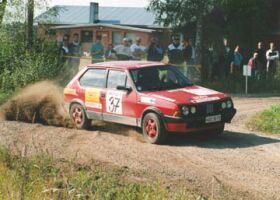 Initially it is relatively easy to replace
the brake discs with drilled and grooved items, and the pads for a harder
compound. The latter should not be too hard (ie no race pads on the road)
or they will not function effectively at the normal 'road' operating temperatures.
Stainless steel braided flexible hoses will improve the pedal feel and
reduce the chance of damage whilst DoT5 fluid (not silicon) will increase
the temperature at which it can operate effectively. If the brakes are
getting too hot the dustguards can be removed and/or ducts fitted, taking
air from behind the front bumper.
Initially it is relatively easy to replace
the brake discs with drilled and grooved items, and the pads for a harder
compound. The latter should not be too hard (ie no race pads on the road)
or they will not function effectively at the normal 'road' operating temperatures.
Stainless steel braided flexible hoses will improve the pedal feel and
reduce the chance of damage whilst DoT5 fluid (not silicon) will increase
the temperature at which it can operate effectively. If the brakes are
getting too hot the dustguards can be removed and/or ducts fitted, taking
air from behind the front bumper.
3. The suspension.
The easiest improvement,and the one which
will probably bring the single most noticeable change, is to replace the
dampers and springs. At the front, everything can be replaced, at the rear
the suspension can be lowered by clamping the leaf spring. Fitting lowered
springs will improve the cornering, but must be fitted together with shortened
throw dampers, or else the springs may unseat ! Top adjustable dampers
are compromised, but are good for road and track day cars since it allows
the suspension to be adjusted between these two, rather different, requirements.
Coil over units add more adjustability and can be purchased outright, or
can be made from standard dampers by welding a threaded sleeve to the standard tube.
Into this category also fall the choice
of wheels and tyres. With an increase in power it can be necessary to fit
larger tyres (thus requiring larger wheels) but the temptation to fit the
biggest possible should be resisted. Consideration should be given to fitting
a wider tyre on the front (since they provide traction and steering) but
keeping the standard, or a wider but not as wide as the front, tyre at
the rear. This will improve the balance of the car.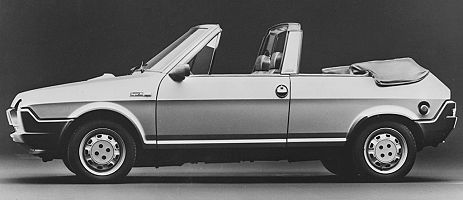 There are then two other main suspension
aims; to reduce the flexiblity in the suspension and to increase the stiffness
of the car, both of which aim at more accurate control of the wheel movement.
To reduce the flexibility it is possible to fit nylon bushes instead of
the normal production rubber items, or if perfection is desired the suspension
can be fitted with metallic bearings (rose joints / rod ends). Spherical
bearing top mounts can also be used. To stiffen the car it is most popular
to fit strut braces. These can be fitted to the front and rear. For more
extreme cases a rollcage can be fitted.....
There are then two other main suspension
aims; to reduce the flexiblity in the suspension and to increase the stiffness
of the car, both of which aim at more accurate control of the wheel movement.
To reduce the flexibility it is possible to fit nylon bushes instead of
the normal production rubber items, or if perfection is desired the suspension
can be fitted with metallic bearings (rose joints / rod ends). Spherical
bearing top mounts can also be used. To stiffen the car it is most popular
to fit strut braces. These can be fitted to the front and rear. For more
extreme cases a rollcage can be fitted.....
4. other things.
Other modifications worth considering include fitment of a shift light (and rev limiter if there is not one as standard), higher power bulbs in the headlights (if you are going to go faster you need to see further) and installation of a quicker steering rack.
Buying / Selling
Tidy inside the car thoroughly : hoover
the floor, empty all pockets, ashtrays (wash), glove compartment etc...,
wipe the trim with a damp cloth, give the cockpit a good airing to get rid of any odours ! Reset
the trip meter to 00000 - it is a pleasant (subconcious) surprise.
If the car has been standing give it a
good run - this will clear out the engine (reduce exhaust smoke), put a
shine on the brake discs and loosen up any joints that may otherwise make some noises.
'Back to black' products are very effective
at temporarily restoring bumpers and trim. This makes a big difference
to any car. Do it a week before you expect people to view the car, otherwise it may be a bit too obvious !
Jetwash under the car, especially under
the engine and in the wheelarches. The prospective buyer may be an enthusiast,
and this makes it easier for them to see what they want to check.
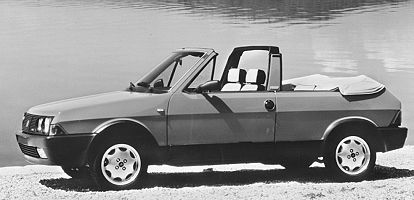 Some tips to do before selling :
(they may seem obvious, but most people don't do them and thus are in a
weaker bargaining position)
Some tips to do before selling :
(they may seem obvious, but most people don't do them and thus are in a
weaker bargaining position)
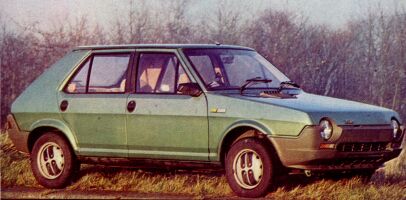 Obviously wash the car and clean the windows !
Obviously wash the car and clean the windows !
If you are going to buy a car always check the following :
Being an old Fiat, you must always check
the bodywork thoroughly. Pay special attention to the wheelarches (inside
if there is no plastic splash guard), suspension and engine mounts, sill,
door pillars (check for sagging doors), scuttle panel and the floor (doors,
bonnet and boot/hatch are also susceptible, but are more easily replaced).
If a sunroof is fitted check around the edge for signs of rust. Check that
there are no mismatching panels, large areas of discolouration or signs of fresh paint.
Check for a damp carpet or the presence
of mould - if the carpet is damp then the floor is almost certainly corroded.
Check the main electrical functions - wipers,
lights, etc... try putting the main beam and wipers on at the same time.
Check the headlight reflectors for rust.
Check the brake pedal does not go to the
floor if pressed hard for a long time and check the gearchange for clean engagement.
Check tyre wear, uneven patterns could imply a bent chassis.
Always take it for a test drive. Check
that the car tracks in a straight line with no steering input and remains
in a straight line under braking. Find a large open area and complete several
lock to lock turns (also in reverse), listening for any noises. Try the
handbrake when moving - seized rear callipers will mean uneven braking or no braking.
Generally, Ritmo's/Strada's are mechanically
pretty good, but the bodywork was weak.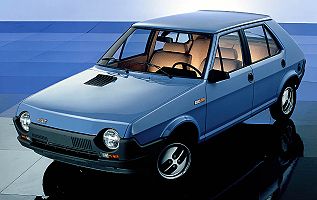 The engine should be run up to temperature, check the exhaust for smoke, the
condition of the breather (look for mayonaise), the condition of the oil
filler cap (again white deposits can indicate head gasket or other serious
problems) and the colour of the coolant (preferably not brown!). If it
has an oil pressure guage this should not drop below 1 bar at idle, and
should be around 3 to 4 bar at speed. Listen to the noise of the engine,
then depress the clutch and engage first gear. Whatever noise has disappeared
was coming form the gearbox, what remains is from the engine. Check the
colour of the oil using the dipstick. A golden-brown is best, darker brown
is ok, but thick and black should be avoided.
The engine should be run up to temperature, check the exhaust for smoke, the
condition of the breather (look for mayonaise), the condition of the oil
filler cap (again white deposits can indicate head gasket or other serious
problems) and the colour of the coolant (preferably not brown!). If it
has an oil pressure guage this should not drop below 1 bar at idle, and
should be around 3 to 4 bar at speed. Listen to the noise of the engine,
then depress the clutch and engage first gear. Whatever noise has disappeared
was coming form the gearbox, what remains is from the engine. Check the
colour of the oil using the dipstick. A golden-brown is best, darker brown
is ok, but thick and black should be avoided.
Links
The Fiat Ritmo TC register website
An Abarth Ritmo/Strada website
![]() For books on Fiat see our Online Bookstore
For books on Fiat see our Online Bookstore
There is also a list of all our picture galleries (including museums, motorshows and various events).
Wallpapers/Desktop Backgrounds of numerous Fiats also available to download.
Ritmo/Strada comment form
Your Comments
In the UK there seem very
few Stradas on the road these day - but our Comfort Model - "A" Registration
(1983 first registered) is still hanging in there. We did leave it in the
garage pretty much unused for five years but it now has about 89k on the
clock. There are plenty of technical reservations - which FIAT may have
addressed in later models - like window winders that loose there grip -
an the engine hates the UK climate - the choke is obligatory except in
the height of summer. This means that the engine suffers when it is only
used for short runs - and it needs some good long journeys to 'clear
its throat'! However - I do enjoy driving the beast because, although you
have to be 'physical' with the gear shift - its not like the clinical driving
in todays saloons - another robotic driver - you know, like the lunatic
in the VW advert who is so overwhelmed by the luxurious sense of his car
that he's content to sit his life-out in a traffic jam. Well the car has
probably depreciated in value to £500 - and its been like that for
the last 10 years - so we're hanging on in. Anyone got any better offers!!? (Brian, UK)
I owned a 1980 Fiat Strada in Metropolitan New York. I drove it almost 145,000 miles with only wheel bearing problems.
Always handled great, got great mileage and was very sad to see it go.
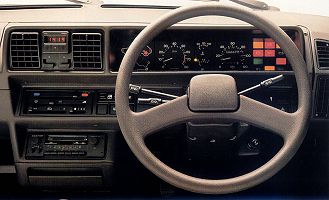
Use the buttons at the top to navigate further, or
Copyright © 2000 to 2008 CarsfromItaly